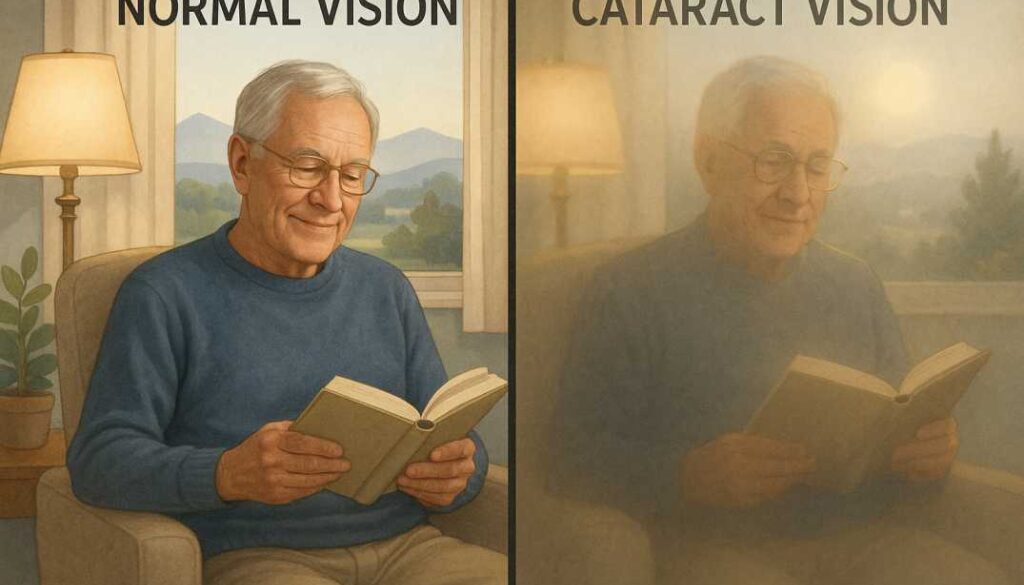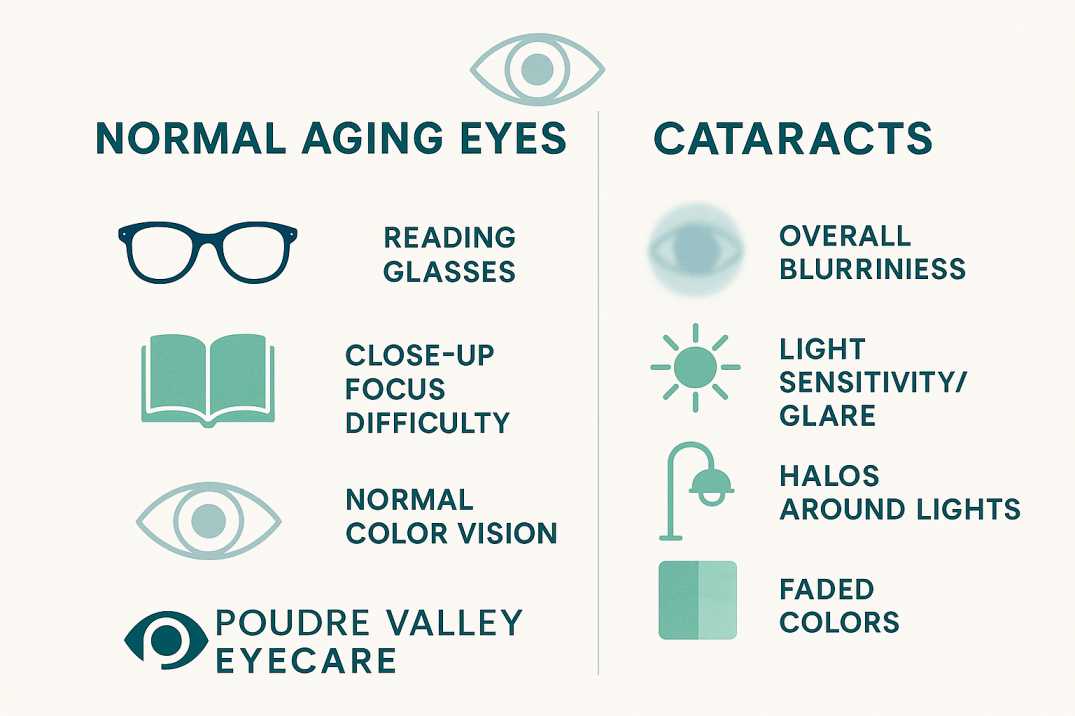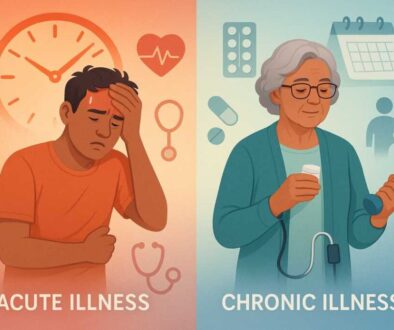Aging Eyes or Cataracts? Key Signs to Watch
The bottom line: While many vision changes are a normal part of aging, cataracts produce distinct warning signs that require professional evaluation. Recognizing these key differences can help you seek timely treatment and protect your long-term eye health.
You’ve noticed your vision isn’t quite what it used to be. Perhaps you’re holding your phone at arm’s length to read texts, or you need brighter lights for reading. It’s natural to wonder: “Is this just normal aging, or could it be cataracts?”
This question concerns millions of Americans, especially those over 40 who are beginning to experience their first noticeable vision changes—affecting an estimated 128 million Americans with presbyopia and over 25 million with cataracts.
Understanding the difference between normal aging eyes and cataracts isn’t just about curiosity—it’s about protecting your vision and maintaining your quality of life. While some vision changes are indeed a natural part of aging eyes, cataracts produce specific warning signs that shouldn’t be ignored.
Quick Answer: How to tell the difference:
- Normal aging eyes (presbyopia): Difficulty focusing on close objects only, usually begins around age 40, corrected with reading glasses
- Cataracts: Blurred vision at all distances, light sensitivity, colors appear faded, halos around lights, frequent prescription changes
Understanding Normal Aging Eyes vs. Cataracts
As we age, our aging eyes naturally undergo changes that can affect our vision. The most common age-related change is presbyopia, which typically begins in our early 40s. This condition occurs when the lens in your eye becomes less flexible, making it harder to focus on close objects. It’s why you might find yourself reaching for reading glasses or holding menus farther away.
Cataracts, however, are fundamentally different. A cataract is a clouding of the lens of the eye, which is typically clear. For people who have cataracts, seeing through cloudy lenses is like looking through a frosty or fogged-up window. While cataracts are age-related, they’re not an inevitable part of aging like presbyopia.
The key distinction lies in how these conditions affect your vision and daily life. Understanding these differences empowers you to seek appropriate care when needed.
Key Warning Signs That Suggest Cataracts
1. Cloudy, Blurred, or Dim Vision
Blurry vision at any distance is the most common symptom of cataracts. Your view may look foggy, filmy, or cloudy. Unlike presbyopia, which primarily affects close-up vision, cataracts can blur your vision at all distances. You might describe it as looking through a dirty windshield that can’t be cleaned.
2. Increased Difficulty with Night Vision
One of the first signs of cataracts is difficulty seeing at night, especially while driving. When cataracts first appear, bright lights and sunshine can alleviate the initial effects of the yellowing of the lens, but cataracts have nowhere to hide at night. If you’re suddenly uncomfortable driving after dark or need more light for evening activities, this could signal developing cataracts.
3. Sensitivity to Light and Glare
Another early symptom of cataracts is glare, or sensitivity to light. You may have trouble seeing in bright sunlight. Indoor lights that once didn’t bother you now may seem too bright or have halos. This sensitivity often becomes more pronounced as cataracts progress.
4. Seeing Halos Around Lights
Many patients begin to notice halos, or colored circles, around objects as their cataracts become increasingly severe. This occurs because the light bends as it passes through the hardened lens. These halos are particularly noticeable around street lights and headlights at night.
5. Colors Appearing Faded or Yellowed
Colors may appear dulled, as if you’re looking through a tinted filter. This is because the proteins that make a cataract cloudy are brownish in hue, so they can affect the way you interpret colors. You might notice that whites appear yellowish or that vibrant colors seem muted.
6. Frequent Changes in Your Prescription
Frequent changes to your eyeglass or contact lens prescription can be a sign of cataracts. This is because cataracts are usually progressive, meaning they get worse over time. If you find yourself visiting your eye doctor more often for prescription updates, it’s worth discussing cataract evaluation.
7. Double Vision in One Eye
Double vision: You may see an image with another “ghost” image next to it. To check if a cataract is the possible cause, close one eye at a time. If the double vision remains when one eye is closed, that’s a sign you may have a cataract in the open eye.
Normal Aging Eyes Changes vs. Cataract Symptoms: Key Differences
Understanding the distinction between normal aging eyes and cataracts is crucial for seeking appropriate care. Here are the key differences:
Normal Aging Eyes (Presbyopia) typically present with:
- Difficulty focusing on close objects only, while distance vision remains clear
- Symptoms usually begin around age 40 and progress gradually
- Both eyes are affected equally and at the same rate
- Vision problems are easily corrected with reading glasses or bifocals
- No increased sensitivity to light or glare
- Colors appear normal and vibrant
- No visual disturbances like halos around lights
Cataracts, in contrast, cause:
- Blurred vision at all distances, not just close-up
- Development can start after age 50-60, becoming noticeable in the 60s and 70s
- Often affects the eyes at different rates, with one eye more affected than the other
- Glasses provide only temporary improvement as the condition progresses
- Increased sensitivity to light and glare, especially problematic at night
- Colors appear faded, yellowed, or less vibrant than normal
- Halos are visible around light sources, particularly street lights and headlights
The telltale difference: The primary distinction is that you can see better with more light when you have cataracts. If you find it’s easier to complete fine focus tasks like reading when you have direct, bright lighting, this may indicate cataracts rather than normal aging eyes. With presbyopia, additional light doesn’t significantly improve close-up vision—you still need reading glasses or magnification.
Who’s at Risk for Developing Cataracts?
While aging is the primary risk factor, several other factors can increase your likelihood of developing cataracts:
Age-Related Risk: Nearly 1 in 5 people age 65 to 74 have cataracts that affect their vision. More than 50% of people over age 80 either have cataracts or have had surgery to remove them. Age-related cataracts may start to develop between the ages of 40 and 50, but typically become noticeable in the 60s and 70s.
- Family history of cataracts
- Diabetes significantly increases cataract risk
- Excessive sun exposure without UV protection
- Smoking doubles your risk of cataract development
- Previous eye injuries or surgeries
- Long-term use of steroid medications
- High blood pressure
- Obesity
The Science Behind Cataracts: Recent Research Insights
Recent scientific advances are providing new hope for cataract treatment and prevention. Three groundbreaking studies from 2024 are particularly noteworthy:
Study 1: Breakthrough Protein Discovery (2024)
Researchers at the National Institutes of Health (NIH) and their collaborators have identified a protein, known as RNF114, that reverses cataracts in animal studies. This research, published in the Journal of Clinical Investigation, offers potential for non-surgical cataract treatment in the future by targeting the cellular mechanisms that cause lens clouding.
Study 2: Non-Surgical Treatment Progress (2024)
A recent phase II clinical trial explored a novel chelation-based approach targeting early cataracts, with promising results. The study showed that patients in the treatment group experienced statistically significant improvements in contrast sensitivity, equivalent to gaining approximately two lines of vision in low-light conditions, with minimal side effects.
Study 3: Nutritional Prevention Research (2024)
Recent comprehensive research published in Frontiers in Nutrition confirmed that factors affecting cataract development include nutrition, oxidative stress, and inflammatory factors. The study reinforced that a balanced diet rich in antioxidants, vegetables, and specific nutrients like vitamins C and E can provide protective effects against cataract formation.
When Normal Aging Becomes Concerning
Understanding when to seek professional evaluation is crucial for maintaining your aging eyes’ health. While some vision changes are expected with age, certain symptoms warrant immediate attention:
Schedule an eye exam if you experience:
- Sudden vision changes
- Rapidly worsening vision
- Difficulty performing daily activities due to vision problems
- Trouble seeing while driving, especially at night
- Increasing dependence on brighter lights for reading
Seek immediate care for:
- Sudden onset of flashing lights
- New floaters accompanied by vision loss
- Severe eye pain
- Sudden double vision
- Complete or partial vision loss
The Importance of Regular Eye Exams
If you’re age 60 or older, get a dilated eye exam every 1 to 2 years. If you’re between 40-54, schedule exams every 2-4 years, and if you’re 55-64, every 1-2 years. The exam is simple and painless — your doctor will give you some eye drops to dilate (widen) your pupil and then check your eyes for cataracts and other eye problems.
Regular comprehensive eye exams are your best defense against vision problems. During these exams, your eye care professional can:
- Detect early signs of cataracts before symptoms develop
- Monitor the progression of existing cataracts
- Identify other aging eye conditions
- Update your prescription as needed
- Recommend appropriate treatment options
At Poudre Valley Eyecare, we’ve been Fort Collins’ trusted partner in eye health for over 25 years. Our comprehensive exams utilize the latest diagnostic technology to detect cataracts and other eye conditions in their earliest stages. As Northern Colorado’s premier eye care practice, we serve families throughout Fort Collins, Loveland, Windsor, and the surrounding communities with Medicare and Medicaid-accepted comprehensive eye care.
Treatment Options: From Management to Surgery
Early-Stage Management
In the initial stages, cataracts can often be managed with:
- Updated prescription glasses or contacts
- Anti-glare coatings on lenses
- Brighter lighting for reading and close work
- Magnifying devices for detailed tasks
When Surgery Becomes Necessary
A cataract only needs to be removed when vision loss gets in the way of your daily activities. These include driving, reading, or watching TV.
Current Statistics (2025):
- Over 4 million cataract surgeries are performed annually in the United States
- 95% to 98% of patients achieve fully restored or significantly improved vision
- Less than 0.5% experience severe complications
- 3.8 million pairs are performed annually in the USA, with over 20 million internationally
Modern cataract surgery offers:
- Outpatient procedure – usually takes less than 30 minutes
- Exceptional success rates – 95% to 98% of patients achieve fully restored or significantly improved vision
- Quick recovery – most people return to normal activities within days
- Advanced lens options – including multifocal lenses that can reduce dependence on glasses
- Low complication rates – severe complications occur in 0.5% or fewer cases
Prevention and Lifestyle Factors
While you can’t prevent all cataracts, several lifestyle choices can reduce your risk:
Protective Measures:
- Wear UV-blocking sunglasses when outdoors
- Don’t smoke – or quit if you currently smoke
- Maintain a healthy diet rich in antioxidants
- Manage diabetes and other health conditions effectively
- Limit alcohol consumption
- Protect your eyes from injuries during sports and work
Eye-Healthy Foods:
Focus on foods rich in:
- Vitamin C – citrus fruits, berries, leafy greens
- Vitamin E – nuts, seeds, vegetable oils
- Lutein and zeaxanthin – leafy greens, corn, eggs
- Omega-3 fatty acids – fish, walnuts, flaxseeds
Living with Cataracts: Practical Tips
If you’re managing early-stage cataracts, these strategies can help maintain your quality of life:
For Better Vision:
- Use brighter, focused lighting for reading
- Choose large-print books and materials
- Reduce glare with anti-reflective coatings
- Use magnifying tools for detailed work
For Safety:
- Avoid driving at night if vision is compromised
- Ensure adequate lighting on stairs and walkways
- Remove tripping hazards from your home
- Consider contrast tape on step edges
Your Eye Health Journey: What to Expect
Understanding the progression of cataracts helps you prepare for the journey ahead:
Early Stage: Minimal vision impact, manageable with glasses and lighting adjustments
Moderate Stage: Noticeable vision changes affecting daily activities
Advanced Stage: Significant vision impairment requiring surgical intervention
Remember, cataract progression varies greatly among individuals. Some people may have cataracts for years with minimal impact, while others may experience rapid changes. Regular monitoring allows your eye care team to recommend the optimal timing for any interventions.
Take Action for Your Vision Health
The difference between normal aging and cataracts isn’t always clear, but you don’t have to navigate this uncertainty alone. At Poudre Valley Eyecare, we combine over 25 years of trusted experience with the latest diagnostic technology to provide you with clear answers and personalized care.
Your next steps:
- Schedule a comprehensive eye exam if you’re experiencing any vision changes
- Discuss your symptoms honestly with your eye care professional
- Ask about your family history and personal risk factors
- Follow recommended screening schedules based on your age and risk profile
Conclusion: Protecting Your Vision for Years to Come
While some vision changes are a natural part of aging eyes, cataracts require professional attention and appropriate treatment. By understanding the warning signs and seeking timely care, you can maintain clear vision and continue enjoying the activities you love.
Don’t let uncertainty about your vision hold you back. Whether you’re experiencing your first vision changes or have been managing cataracts for some time, our experienced team is here to guide you through every step of your eye health journey.
The choice between wondering “Is it cataracts or just aging?” and getting clear answers is yours. Take the first step toward protecting your vision – your future self will thank you.
Additional Resources & Scientific References
For readers interested in diving deeper into the latest research on cataracts, aging eyes, and treatment options, we recommend these authoritative sources referenced in this article:
1. National Institutes of Health (NIH) – Breakthrough Cataract Research
“Reversible cold-induced lens opacity in a hibernator reveals a molecular target for treating cataracts”
Published in Journal of Clinical Investigation, 2024
This groundbreaking study identified the RNF114 protein that may lead to non-surgical cataract treatments in the future.
Learn more about NIH cataract research
2. National Eye Institute – Comprehensive Cataract Information
“Cataracts: Facts About Age-Related Eye Disease”
Updated 2024
Provides current statistics, risk factors, and treatment options for cataracts, including the latest surgical advances and success rates.
Visit the National Eye Institute
3. Frontiers in Nutrition – Nutritional Prevention Research
“Research progress on the correlation between cataract occurrence and nutrition”
Published July 2024
Comprehensive meta-analysis showing how diet, antioxidants, and specific nutrients can help prevent cataract formation.
Read the nutrition research.
These resources provide evidence-based information to support the content in this article. Always consult with your eye care professional for personalized medical advice.
Related Eye Health Topics
Continue Learning About Your Eye Health:
- Comprehensive Eye Exams: Understanding what to expect during your Fort Collins eye examination
- Presbyopia Treatment Options: Reading glasses, bifocals, and progressive lenses explained
- Diabetic Eye Care: How diabetes affects your vision and prevention strategies
- Glaucoma Screening: Early detection and treatment in Northern Colorado
- Macular Degeneration: Age-related vision changes and treatment options
- Contact Lens Fittings: Modern options for aging eyes and presbyopia correction
Schedule Your Eye Health Consultation: Ready to determine if your vision changes are normal aging or cataracts? Our experienced Fort Collins eye care team provides comprehensive evaluations using the latest diagnostic technology. We accept most insurance plans, including Medicare and Medicaid, making quality eye care accessible to all Northern Colorado families.
Ready to get answers about your vision changes? Contact Poudre Valley Eyecare today to schedule your comprehensive eye examination. With over 25 years of trusted care in Fort Collins, we’re here to help you see clearly at every stage of life.
About Poudre Valley Eyecare: Located in Fort Collins, Colorado, Poudre Valley Eyecare has been Northern Colorado’s trusted eye care provider for over 25 years. Our comprehensive services include routine eye exams, cataract evaluation and co-management, diabetic eye care, glaucoma screening, and contact lens fittings. We accept Medicare, Medicaid, and most insurance plans, serving families throughout Fort Collins, Loveland, Windsor, and surrounding communities.
FAQs
-
Early cataract symptoms include blurry vision, increased glare sensitivity, and difficulty seeing at night. Normal aging may cause slower focus changes.
Please note: None of the above should be considered medical advice. If you’re having any concerns about your vision, please reach out to us immediately or see your primary care provider.






